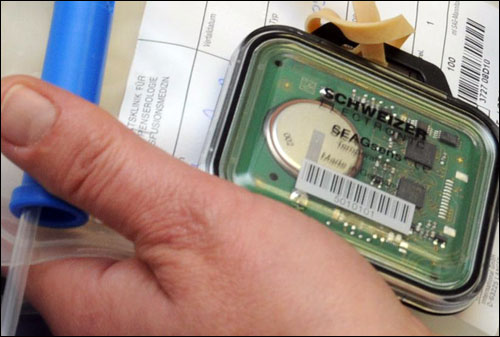German logistics giant DB Schenker is employing RFID tags with temperature-logging capabilities to track the conditions under which sensitive medical goods are transported to the United States. The tags are being rolled out for temperature-tracking applications involving products forwarded by air, sea, land and rail.
According to Eleftherios Skountridakis, who leads DB Schenker’s RFID implementation efforts in Germany, the temperature-tracking project for airfreight—which began with an initial pilot in January 2010, and continued in October with ongoing testing of the technology—is now utilizing 350 battery-assisted passive, reusable tags. Most were rolled out to track goods that begin their journey at DB Schenker’s warehouse in Mannheim, and that must be stored at temperatures between 2 degrees and 8 degrees Celsius (35.6 degrees and 46.4 degrees Fahrenheit), or between 15 degrees and 25 degrees Celsius (59 degrees and 77 degrees Fahrenheit), depending on the product.

DB Schenker relies on tags designed by Siemens that were originally created for blood-monitoring applications.
“Our research showed that the solution was the best one from a pricing, calibration and battery-life perspective,” Skountridakis explains. Only the tags’ software was modified, in order to make it compatible with the company’s database, as well as provide greater detail for the DB Schenker application. The tags include a small LED light that blinks red multiple times if temperatures fall outside of a pre-designated range. If temperatures have remained within the defined range, the light blinks green every six seconds. The 13.56 MHz high-frequency (HF) tags, known as SensoTags, are manufactured by Schweizer Electronic, located in Germany. These tags contain 60 kilobytes of memory, and comply with the ISO 15693 RFID standard. Each tag is encoded with a 16-digit alphanumerical unique ID number, which is also printed on the tag’s exterior as a bar code.
Each week, DB Schenker and its client—a global pharmaceuticals company that DB Schenker declines to name—decide which goods will be monitored in two temperature-controlled shipments to the United States. The selected goods are often reagents—liquid solutions transported in small jars, and used to identify illnesses. The firm’s client is using RFID tags to monitor shipping temperatures as part of its quality-control measures, and to comply with regulations of the U.S. Food and Drug Administration (FDA).
DB Schenker is covering the cost of the RFID test, which involves shipments to five U.S. companies. The firm is utilizing the application to demonstrate to its customers its ability to manage the cold chain. “The proof will be in the RFID tags,” Skountridakis states. “It’s a door-opener with new customers.” What’s more, DB Schenker wants to verify that airlines are meeting their commitments to control temperatures.Once the type of goods to be tagged has been defined, DB Schenker attaches the tags to a sampling of the designated items within the shipment. “The aim is to tag two to five items per flight,” Skountridakis says, “to perform a spot-check that records the temperatures in which the goods are shipped.”
Tags may be attached in a variety of positions on a number of different carriers, such as on the wooden Euro pallets used to hold boxes, or on the boxes themselves. “It does not matter so much where we place the tags,” Skountridakis says, “because we’re testing the temperature outside of the boxes.”
DB Schenker has invested more than €100,000 ($145,000) in the project, including payments to consultants, as well as spending on training and computer systems. At present, the company’s management is considering a global rollout of the RFID application.
At its warehouse, DB Schenker employs a desktop RFID reader using OBID i-scan HF proximity technology, manufactured by Feig Electronic, to read the tag IDs, and then applies the tags to pallets or transport boxes. The goods are transferred by truck to Luxembourg, to be loaded onto airfreight pallets and then onto an airplane. The tags record a temperature reading every 15 minutes.
Upon arrival in the United States, the goods are unloaded at a DB Schenker warehouse, and are then removed from the pallets. Before the shipment is moved into temporary storage and then forwarded to one of the five customers, a worker visually identifies RFID-tagged packages via the tag’s LED light, or by manually checking a paper list of RFID-tagged items within the particular shipment.
The worker then removes the tags from the items, and moves them to a desk on which a reader is mounted. The temperature recorded on the tags, along with the date and time of each temperature read, are then transferred via RFID to the client’s computer system. If the computer detects that temperatures remained stable, DB Schenker does not communicate the readings to its client—it only notifies the customer via an electronic message if it believes that temperatures may have varied outside the designated range.DB Schenker had tested handheld readers, Skountridakis says, but it has yet to find the right model. The company will eventually need to choose a suitable handheld to expand the application, he adds, since manually searching for tags, pulling them off and reading them at a desk is too cumbersome a process when a large number of items are tagged.
Software designed by Siemens, loaded on the tags, controls the temperature-measurement function, and can operate in standalone mode so that a user can configure, start and stop measurements, as well as view data stored on the SensoTag and export it to a file system, without requiring access to the customer’s network and database server.
In tests of the tags conducted for monitoring temperatures during sea transport, DB Schenker has applied three tags to the inside walls of sea-freight containers. The company has tested the use of three tags on the inside walls of truck trailers and rail cars as well.
As the tags’ use continues, Skountridakis says, the positioning of the tag—either on the container walls, or on individual items—will depend on the client’s requirements, government regulations, and DB Schenker’s assessment of the cool and hot spots within each shipping environment. Some customers do not want their logistics partners to touch goods after they have been shipped, he notes, so the only option is to place the tags on container walls.
According to Skountridakis, DB Schenker plans to use the application globally for top destinations.


